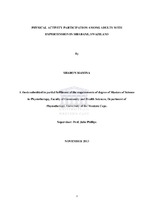| dc.description.abstract | Scientific studies have shown that chronic diseases of lifestyle (CDL) such as hypertension and diabetes mellitus are major causes of mortality and morbidity, accounting for about 60% of the disease burden globally. Available statistics for Swaziland indicate that hypertension and heart diseases are on the increase and are responsible for 33,540 and 3,146 cases per year respectively. Regular physical activity (PA) is widely recognised as a means for the primary and secondary
prevention of CDL due to their multi-factorial beneficial effects on an individual‟s health. Therefore, the aim of this study was to determine PA participation among adults with hypertension in Mbabane, Swaziland and the extent to which they are encouraged to be physically active. A cross-sectional design, utilising quantitative methods was employed in the study and three validated standardised interview administered questionnaires were used to collect data from both hypertensive individuals and health professionals. A sample size of 422 hypertensive individuals and 72 health professionals was included in the study. Statistical Package for Social
Sciences (SPSS) version 20 was used to analyse the data. Descriptive statistics were employed to summarise data and was expressed as means, standard deviation, frequencies and percentages. The Students‟t-test was used to compare mean age and PA. Chi-square tests were used to test for associations between categorical variables with significant levels set at 5% (p < 0.05). Blood pressure was classified into controlled (≤ 140/≤ 90 mmHg) and uncontrolled (≥ 140/≥ 90 mmHg). PA was dichotomised into active (> 600 MET-minute/week) and sedentary (< 599 METminute/ week). BMI was classified as underweight (<18.5), normal (18.5-24.9), overweight (25-29.9) and obese (>30). The findings of the current study revealed that a considerable number of individuals with hypertension (53%) were physically inactive with poorly controlled blood pressure (57%). A statistical significance was found between mean age and PA (sedentary and active) (P= 0.000 ˂ 0.05). iii The study also revealed that the perceived benefits of PA as reported by individuals with hypertension outweighed the perceived barriers. In addition, the majority of health professionals were found to be poor counsellors of PA (58%). Most health professionals informed their patients on becoming physically active but did not include important components of PA counselling such as the types of PA, intensity and duration. The common reasons for not including PA as part of the daily routine include: not my area of specialty and lack of time. These factors could significantly contribute to sedentary behaviour among hypertensive individuals in developing countries such as Swaziland. For this reason, an urgent need for PA promotion programmes which will motivate hypertensive individuals to participate in sufficient levels of PA as recommended by public health research has been established. The programmes should include educating health professionals on current trends in the promotion of PA. A combination of these approaches will
help to reduce morbidity and mortality from cardio-vascular disease (CVD), in particular hypertension. | en_US |

